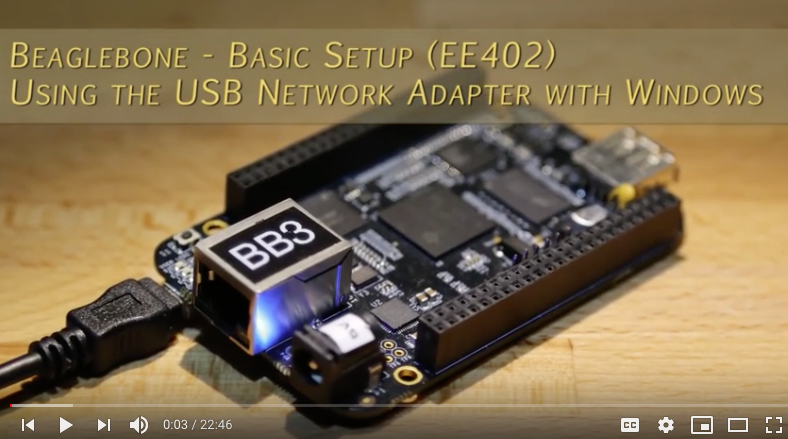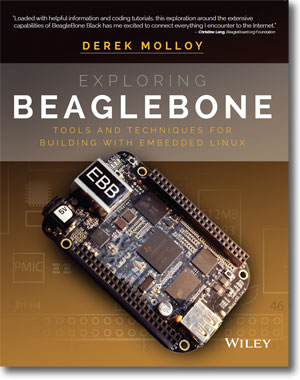We caught up with Derek Molloy, Author and Sr Lecturer in the School of Electronic Engineering at Dublin City College to chat about his use of BeagleBoard in the classroom and what inspired him to write a textbook and a series of very popular YouTube videos using them. (Part 1 of 2 Parts)
What was your first introduction to BeagleBoard.org ?
I first began working with the BeagleBoard-xM and BeagleBone (white) in 2011/2012 when I was looking for a way to integrate high-level programming with electronic devices for research and teaching needs.
What intrigued you about the boards?
I was fascinated by the fact that these boards allowed high-level software and low-level electronics to be co-designed on a single platform, particularly in a connected environment. I had written a lot of low-level code on devices that involved register programming but I always found the hard-wired internet support to be clunky or overly bespoke. The simplicity by which you could control GPIOs using the Linux OS without even writing a line of code meant that all manner of high-level languages could be utilized for interfacing applications. Linux support also meant that there was support for GUI development, image processing, and emerging networking standards.
I reviewed several boards but the BeagleBone stood out in particular for a number of reasons as my board of choice:
- The compact form factor was perfect for projects that had to be integrated into a physical rig.
- The range of I/O available was very strong and the female headers made interfacing easy.
- The quality of the TI documentation on the AM335x itself was amazing — that is certainly not the case for other boards.
- The price point was good, which meant that I could integrate it into my taught modules.
- The real time PRUs were interesting and somewhat elusive!
You have over 1M viewers on your YouTube channel – that’s rockstar level – what are developers and students learning while on your site?
 I originally developed the YouTube channel to support an early stage module on digital and analog electronics. I developed an electronics kit that supported DCU students through a flipped-laboratory model that and the YouTube videos were designed to support the large numbers of students in the module. The local feedback on the videos was strong, so I brought them to my later stage modules on object-oriented programming with embedded systems.
I originally developed the YouTube channel to support an early stage module on digital and analog electronics. I developed an electronics kit that supported DCU students through a flipped-laboratory model that and the YouTube videos were designed to support the large numbers of students in the module. The local feedback on the videos was strong, so I brought them to my later stage modules on object-oriented programming with embedded systems.
It’s easy to forget how big the world is when you are busy in a university in Ireland with teaching and research. YouTube brings a global audience to your work! One of my main hopes is that the videos help students and developers to get over the initial shock of working with new technologies and concepts.
Your book as been referenced as the “definitive guide” – what classes are instructors teaching with it?
I know from feedback that Exploring BeagleBone: Tools and Techniques for Building with Embedded Linux 1st Edition is being used in countries around the world to support undergraduate students in electronic and computer engineering, postgraduate students in mechatronics engineering and many others. It has been translated into Chinese and Korean. The book is used in a wide range of module types, for example, network communications, operating systems, Internet of Things, and robotics. As a result, the book is typically being used to supplement core texts for the module in question with a practical guide to working with embedded Linux and interfacing electronics on the BeagleBone boards.
What’s next for the book? ( and videos?)
The next revision of the book will bring the first edition content up to date — the Linux OS is a constantly moving target and everyone wants to take advantage of the latest kernel developments. It brings in further support for new board developments (e.g., the PocketBeagle and BeagleBone Black Wireless) as well as CAN Bus and new IoT technologies, and updating the content on the PRU-ICSS to utilize remoteproc.
Future revisions and video will include support for whatever great board developments that the BeagleBoard.org Foundation can come up with! I’m particularly interested in heterogeneous processing and the general principle of offloading workload from the cloud to the edge of the network, particularly for computer vision and “Internet of Eyes” applications.
I hope to develop new video content soon, but I just wish there were more hours in every day!

